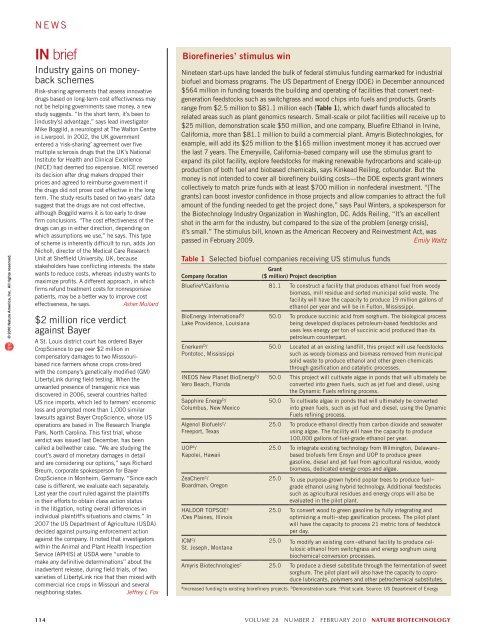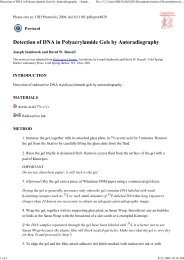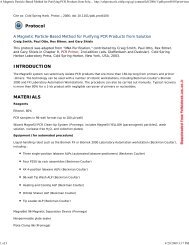© 2010 Nature America, Inc. All rights reserved.NEWSin briefIndustry gains on moneybackschemesRisk-sharing agreements that assess innovativedrugs based on long-term cost effectiveness maynot be helping governments save money, a newstudy suggests. “In the short term, it’s been to[industry’s] advantage,” says lead investigatorMike Boggild, a neurologist at The Walton Centrein Liverpool. In 2002, the UK governmententered a ‘risk-sharing’ agreement over fivemultiple sclerosis drugs that the UK’s NationalInstitute for Health and Clinical Excellence(NICE) had deemed too expensive. NICE reversedits decision after drug makers dropped theirprices and agreed to reimburse government ifthe drugs did not prove cost effective in the longterm. The study results based on two-years’ datasuggest that the drugs are not cost effective,although Boggild warns it is too early to drawfirm conclusions. “The cost effectiveness of thedrugs can go in either direction, depending onwhich assumptions we use,” he says. This typeof scheme is inherently difficult to run, adds JonNicholl, director of the Medical Care ResearchUnit at Sheffield University, UK, becausestakeholders have conflicting interests: the statewants to reduce costs, whereas industry wants tomaximize profits. A different approach, in whichfirms refund treatment costs for nonresponsivepatients, may be a better way to improve costeffectiveness, he says.Asher Mullard$2 million rice verdictagainst BayerA St. Louis district court has ordered BayerCropScience to pay over $2 million incompensatory damages to two Misssouribasedrice farmers whose crops cross-bredwith the company’s genetically modified (GM)LibertyLink during field testing. When theunwanted presence of transgenic rice wasdiscovered in 2006, several countries haltedUS rice imports, which led to farmers’ economicloss and prompted more than 1,000 similarlawsuits against Bayer CropScience, whose USoperations are based in The Research TrianglePark, North Carolina. This first trial, whoseverdict was issued last December, has beencalled a bellwether case. “We are studying thecourt’s award of monetary damages in detailand are considering our options,” says RichardBreum, corporate spokesperson for BayerCropScience in Monheim, Germany. “Since eachcase is different, we evaluate each separately.Last year the court ruled against the plaintiffsin their efforts to obtain class action statusin the litigation, noting overall differences inindividual plaintiff’s situations and claims.” In2007 the US Department of Agriculture (USDA)decided against pursuing enforcement actionagainst the company. It noted that investigatorswithin the Animal and Plant Health InspectionService (APHIS) at USDA were “unable tomake any definitive determinations” about theinadvertent release, during field trials, of twovarieties of LibertyLink rice that then mixed withcommercial rice crops in Missouri and severalneighboring states.Jeffrey L FoxBiorefineries’ stimulus winNineteen start-ups have landed the bulk of federal stimulus funding earmarked for industrialbiofuel and biomass programs. The US Department of Energy (DOE) in December announced$564 million in funding towards the building and operating of facilities that convert nextgenerationfeedstocks such as switchgrass and wood chips into fuels and products. Grantsrange from $2.5 million to $81.1 million each (Table 1), which dwarf funds allocated torelated areas such as plant genomics research. Small-scale or pilot facilities will receive up to$25 million, demonstration scale $50 million, and one company, Bluefire Ethanol in Irvine,California, more than $81.1 million to build a commercial plant. Amyris Biotechnologies, forexample, will add its $25 million to the $165 million investment money it has accrued overthe last 7 years. The Emeryville, California–based company will use the stimulus grant toexpand its pilot facility, explore feedstocks for making renewable hydrocarbons and scale-upproduction of both fuel and biobased chemicals, says Kinkead Reiling, cofounder. But themoney is not intended to cover all biorefinery building costs—the DOE expects grant winnerscollectively to match prize funds with at least $700 million in nonfederal investment. “[Thegrants] can boost investor confidence in those projects and allow companies to attract the fullamount of the funding needed to get the project done,” says Paul Winters, a spokesperson forthe Biotechnology Industry Organization in Washington, DC. Adds Reiling, “It’s an excellentshot in the arm for the industry, but compared to the size of the problem [energy crisis],it’s small.” The stimulus bill, known as the American Recovery and Reinvestment Act, waspassed in February 2009.Emily WaltzTable 1 Selected biofuel companies receiving US stimulus fundsCompany /locationGrant($ million) Project descriptionBluefire a /California 81.1 To construct a facility that produces ethanol fuel from woodybiomass, mill residue and sorted municipal solid waste. Thefacility will have the capacity to produce 19 million gallons ofethanol per year and will be in Fulton, Mississippi.BioEnergy International b /Lake Providence, LouisianaEnerkem b /Pontotoc, MississippiINEOS New Planet BioEnergy b /Vero Beach, FloridaSapphire Energy b /Columbus, New MexicoAlgenol Biofuels c /Freeport, TexasUOP c /Kapolei, HawaiiZeaChem c /Boardman, OregonHALDOR TOPSOE c/Des Plaines, IllinoisICM c /St. Joseph, Montana50.0 To produce succinic acid from sorghum. The biological processbeing developed displaces petroleum-based feedstocks anduses less energy per ton of succinic acid produced than itspetroleum counterpart.50.0 Located at an existing landfill, this project will use feedstockssuch as woody biomass and biomass removed from municipalsolid waste to produce ethanol and other green chemicalsthrough gasification and catalytic processes.50.0 This project will cultivate algae in ponds that will ultimately beconverted into green fuels, such as jet fuel and diesel, usingthe Dynamic Fuels refining process.50.0 To cultivate algae in ponds that will ultimately be convertedinto green fuels, such as jet fuel and diesel, using the DynamicFuels refining process.25.0 To produce ethanol directly from carbon dioxide and seawaterusing algae. The facility will have the capacity to produce100,000 gallons of fuel-grade ethanol per year.25.0 To integrate existing technology from Wilmington, Delaware–based biofuels firm Ensyn and UOP to produce greengasoline, diesel and jet fuel from agricultural residue, woodybiomass, dedicated energy crops and algae.25.0 To use purpose-grown hybrid poplar trees to produce fuelgradeethanol using hybrid technology. Additional feedstockssuch as agricultural residues and energy crops will also beevaluated in the pilot plant.25.0 To convert wood to green gasoline by fully integrating andoptimizing a multi‐step gasification process. The pilot plantwill have the capacity to process 21 metric tons of feedstockper day.25.0 To modify an existing corn‐ethanol facility to produce cellulosicethanol from switchgrass and energy sorghum usingbiochemical conversion processes.Amyris Biotechnologies c 25.0 To produce a diesel substitute through the fermentation of sweetsorghum. The pilot plant will also have the capacity to coproducelubricants, polymers and other petrochemical substitutes.a Increased funding to existing biorefinery projects. b Demonstration scale. c Pilot scale. Source: US Department of Energy114 volume 28 number 2 february 2010 nature biotechnology
© 2010 Nature America, Inc. All rights reserved.Purpose-built chromosome“It’s functional, and alsoa very good metaphor forwhat the center is tryingto achieve.” Larry Malcic,one of the architects ofLondon’s UK Centre forMedical Research andInnovation (UKCMRI),says scientists exclaimed,“that’s a chromosome,”when he presented thebuilding designs withoutknowing its symbolicsignificance. The new$978 million UKCMRI isbeing built in central London as a partnership between University College London, CancerResearch UK, the Medical Research Council and the Wellcome Trust. It will house fourleading science organizations to conduct biomedical research on genetics, stem cells andcommon diseases, and is expected to open in 2015. (Times, December 8, 2009)in their words“They just wait untilWHO [World HealthOrganization] says‘pandemic’ and activatethe contracts.” WolfgangWodarg, a memberof the German SocialDemocratic Party andchair of PACE healthcommittee, convenientlyshifts blame for Germany’ssurplus H1N1 vaccine stocks on to the companiesthat redirected resources and expertise to make aproduct available in just a few months. (PharmaTimes, January 4, 2010)“These sweetheart deals are being done on thebacks of consumers. From the perspective of theFederal Trade Commission, [they] are one of theworst abuses across the board in healthcare andSelected research collaborationsshould be stopped.” Federal Trade Commission(New York) chairman Jon Leibowitz will press for aprovision in the healthcare reform bill to end dealsin which brand-name drugmakers pay genericproducers to delay copycat versions of best-sellingmeds. (New York Times, January 12, 2010)“The pharmaceutical industry has destroyedso much institutional knowledge over the lastdecade that it makes the Taliban, blowing uptemples, look like high school pranksters.”Anonymous blogger. (In the Pipeline,January 12, 2010)“Cannibalism is rife within the biotech industry!”Barry Canton, a cofounder of Ginkgo Bioworks(Boston), on how his and other companies areacquiring equipment castoffs from universitiesand other companies from online auctioneers.(The Boston Globe, January 4, 2010)newsin briefFDA balks on MedImmune’scell-grown flu vaccineThe shift towards new cell culture–based fluvaccine production has been dealt a blowas MedImmune of Gaithersburg, Maryland,puts its manufacturing efforts on hold. TheAstraZeneca subsidiary took this step afterthe US Food and Drug Administration (FDA)requested follow-on studies that wouldsubstantially increase the cost and time tomarket beyond what the company expected.In its contract with the Department of Healthand Human Services (HHS), MedImmuneproposed an efficacy study comparing immuneresponses in volunteers receiving cellproducedwith those receiving egg-producedvaccines, considering them geneticallyidentical, followed by a large safety trial. Butthe FDA termed cell-grown vaccine a newproduct, requesting Medimmune conduct aclinical trial during an influenza season, aswell as demonstrate efficacy in adults beforevaccinating children. The plan “becamecumbersome and complicated and did notaddress significant scientific and medicalissues we thought we needed to address toadvance this vaccine,” says George Kemble,vice president of vaccine R&D at MedImmune.“I don’t think there is any deliberate delay,”says Anthony Fauci, director of the NationalInstitute of Allergy and Infectious Diseases,noting the move is due to safety and efficacydata gathering. Jose Romero, member of theFDA vaccine advisory committee, comments inan unofficial capacity, “General FDA concernsinclude exposing humans to adventitiousagents that might be lurking in cell linesor the remote possibility of transmitting anoncogene that could create cancer in a humanhost.” Elsewhere, last November, Novartis ofBasel inaugurated a $1 billion cell culture fluvaccine manufacturing facility in partnershipwith the HHS. The plant in Holly Springs,North Carolina, is the first large-scale cellculture flu vaccine and adjuvant productionfacility in the US.Wendy WolfsonPartner 1 Partner 2Alopexx Pharmaceuticals(Cambridge,Massachusetts)Seattle Genetics(Bothell, Washington)Athersys (Cleveland)Sanofi-Aventis(Paris)Millennium/Takeda(Osaka, Japan)Pfizer(New York)Syngenta (Basel) CSR Sugar(Melbourne,Australia)*Financial details not disclosed.$(millions) Details375 Sanofi-Aventis will pay Alopexx for rights to codevelop a monoclonal antibody (mAb) for treating Escherichia coli,Staphylococcus aureus and other infections. Alopexx receives an upfront payment, research funding and is eligiblefor milestone payments that could reach $375 million in total, plus royalties. Sanofi will have the option tolicense the product, which will be in phase 1 trials in 2010.290 Millennium will pay $60 million upfront, plus milestones that could exceed $230 million, to codevelop SeattleGenetics’ brentuximab vedotin (SGN-35). The antibody drug conjugate composed of an anti-CD30 mAb andmonomethyl auristatin E is currently in a pivotal phase 2 trial to treat relapsed and refractory Hodgkin’s lymphoma.Under the agreement, the Takeda Group keeps commercial rights to the drug outside the US and Canadawhere Seattle Genetics retains full rights.111 Pfizer will pay Athersys $6 million initially and up to $105 million in the future for rights to develop Athersys’sstem cells to treat ulcerative colitis and Crohn’s disease. The product, MultiStem, consists of multipotent adultprogenitor cell, and is in early clinical trials for heart attacks and in cancer patients receiving bone marrow transplants.* Syngenta has acquired exclusive global rights, excluding Australia, to CSR Sugar’s SugarBooster, a transgenic technologyto develop cane plants with high sugar content. The license agreement includes milestone payments and royaltieson product sales to CSR Sugar. The terms of the deal were not disclosed.nature biotechnology volume 28 number 2 february 2010 115
- Page 3 and 4: volume 28 number 2 february 2010COM
- Page 5 and 6: in this issue© 2010 Nature America
- Page 7 and 8: © 2010 Nature America, Inc. All ri
- Page 10 and 11: NEWS© 2010 Nature America, Inc. Al
- Page 12 and 13: NEWS© 2010 Nature America, Inc. Al
- Page 14 and 15: NEWS© 2010 Nature America, Inc. Al
- Page 16 and 17: © 2010 Nature America, Inc. All ri
- Page 20 and 21: © 2010 Nature America, Inc. All ri
- Page 22 and 23: NEWS feature© 2010 Nature America,
- Page 24 and 25: uilding a businessComing to termsDa
- Page 26 and 27: uilding a business© 2010 Nature Am
- Page 28 and 29: correspondence© 2010 Nature Americ
- Page 30 and 31: correspondence© 2010 Nature Americ
- Page 32 and 33: correspondence© 2010 Nature Americ
- Page 34 and 35: correspondence© 2010 Nature Americ
- Page 36 and 37: case studyNever againcommentaryChri
- Page 38 and 39: COMMENTARY© 2010 Nature America, I
- Page 40 and 41: COMMENTARY© 2010 Nature America, I
- Page 42 and 43: patents© 2010 Nature America, Inc.
- Page 44 and 45: patents© 2010 Nature America, Inc.
- Page 46 and 47: news and viewsChIPs and regulatory
- Page 48 and 49: news and viewsFrom genomics to crop
- Page 50 and 51: news and views© 2010 Nature Americ
- Page 52 and 53: news and views© 2010 Nature Americ
- Page 54 and 55: e s o u r c eRational association o
- Page 56 and 57: e s o u r c e© 2010 Nature America
- Page 58 and 59: e s o u r c e© 2010 Nature America
- Page 60 and 61: e s o u r c e© 2010 Nature America
- Page 62 and 63: © 2010 Nature America, Inc. All ri
- Page 64 and 65: B r i e f c o m m u n i c at i o n
- Page 66 and 67: i e f c o m m u n i c at i o n sAUT
- Page 68 and 69:
lettersa1.5 kb hVPrIntron 112.5 kbA
- Page 70 and 71:
letters© 2010 Nature America, Inc.
- Page 72 and 73:
letters© 2010 Nature America, Inc.
- Page 74 and 75:
l e t t e r sReal-time imaging of h
- Page 76 and 77:
l e t t e r sFigure 2 Time-lapse li
- Page 78 and 79:
l e t t e r s© 2010 Nature America
- Page 80 and 81:
l e t t e r sRational design of cat
- Page 82 and 83:
l e t t e r s© 2010 Nature America
- Page 84 and 85:
l e t t e r s© 2010 Nature America
- Page 86 and 87:
sample fluorescence was measured as
- Page 88 and 89:
careers and recruitmentFourth quart
















